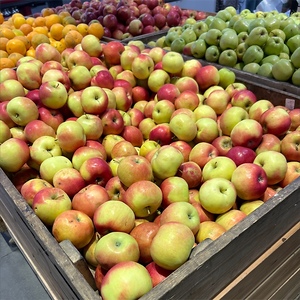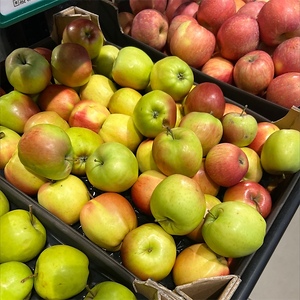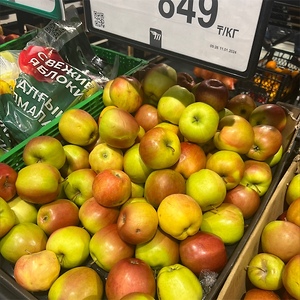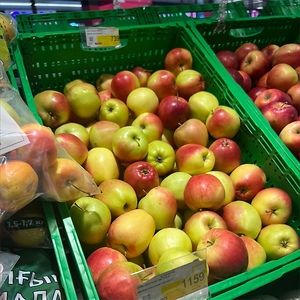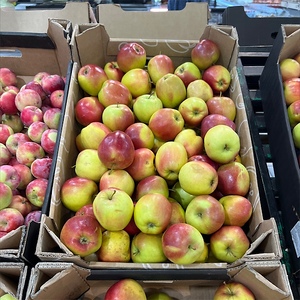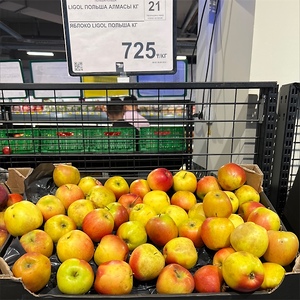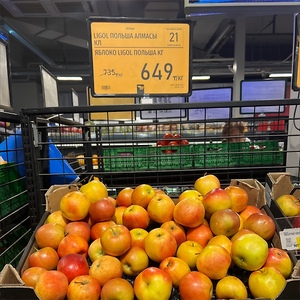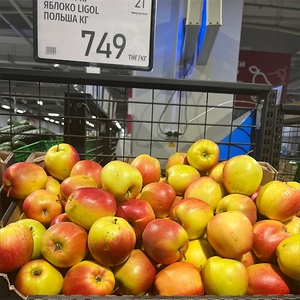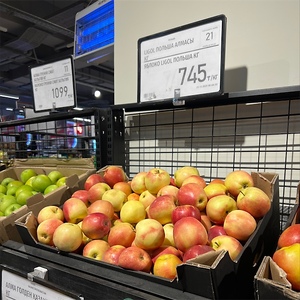

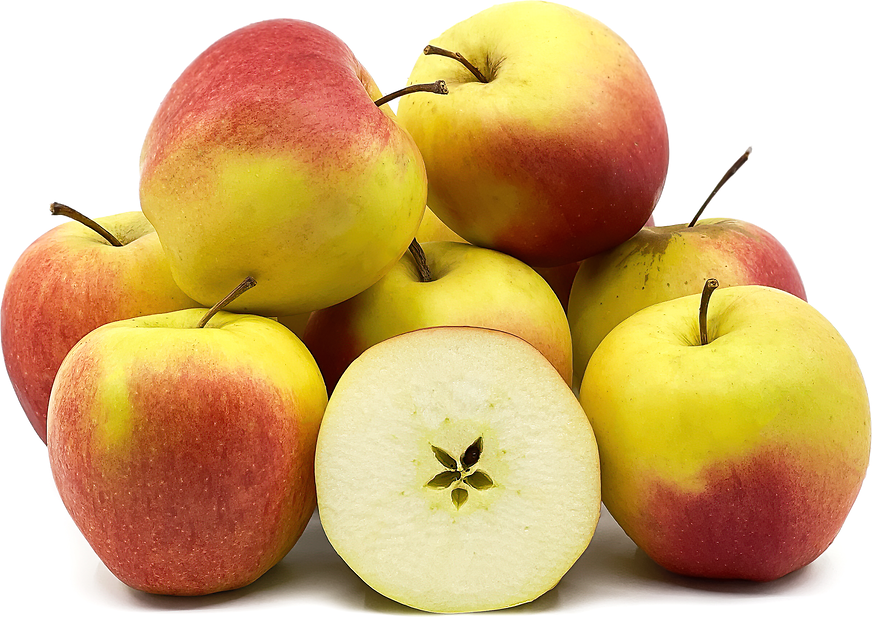
Ligol Apples
Estimated Inventory, lb : 0
Description/Taste
Ligol apples are a medium to large varietal, averaging 200 to 300 grams in weight, and have a round to elongated, conical appearance with flat shoulders tapering to a narrow base. The apple’s skin is thick, tough, and semi-glossy with a slightly oily feel. The skin also has a yellow-green base, ripening into a golden yellow hue, covered in large, blurred patches of bright red blush. Underneath the surface, the white to ivory flesh is firm, dense, and fine-grained with a crisp, crunchy, but tender consistency. The flesh also encases a central fibrous core filled with black-brown seeds. Ligol apples are aromatic and have a sweet flavor with light acidity, creating a sweet-tart, tangy taste.
Seasons/Availability
Ligol apples are harvested in the late fall through early winter. In professional storage, the apples can be stored through the spring.
Current Facts
Ligol apples, botanically classified as Malus domestica, are a Polish variety belonging to the Rosaceae family. The large, colorful apples were developed in the late 20th century and are a modern variety grown on compact, uniform trees reaching 3.5 meters in height. Ligol apples were bred as a commercial variety that showcased improved resistance to disease, frost tolerance, and appearance. After their release, the apples became widely popular throughout Poland and became a favored home garden variety, grown for their high yields, large fruits, and extended storage capabilities. Ligol apples can be eaten straight off the tree or stored for several months without losing flavor, and the apple’s tough skin allows it to be shipped long distances without damage or bruising. Ligol apples are typically consumed as a fresh-eating variety.
Nutritional Value
Ligol apples are a source of fiber to regulate the digestive tract, potassium to balance fluid levels within the body, and vitamin C to strengthen the immune system while reducing inflammation. The apples also contain antioxidants to protect the cells against free radical damage and provide other nutrients, including boron, calcium, phosphorus, magnesium, vitamins A, E, and K, and zinc.
Applications
Ligol apples have a sweet-tart flavor and crunchy texture suited for fresh and cooked preparations. The apples are popularly consumed straight out of hand and are appreciated for their crisp nature and vibrant coloring. Ligol apples can also be tossed into salads, chopped into side dishes, sprinkled with peanut butter and cinnamon, or quartered and served with cheeses on appetizer platters. In addition to slicing, Ligol apples are slow to brown, allowing them to be thinly sliced and used as a garnish on the rim of beverages; and can also be blended into smoothies, pressed into juices, or used to flavor carbonated drinks and cocktails. In Poland, apples are favored for fermenting into cider and are made in home kitchens or sold through craft breweries. While less common, Ligol apples are sometimes incorporated into crisps, crumbles, pies, cakes, and crepes, or stewed with cinnamon, combined with cooked rice and milk. The variety can also be cooked with duck, roasts, and pork, simmered into sauces, or combined with root vegetables to make a savory side dish. Ligol apples pair well with vanilla, spices such as cinnamon, cloves, nutmeg, allspice, and ginger, herbs including parsley, fennel, thyme, and dill, and meats such as pork, poultry, duck, and beef. Whole, unwashed Ligol apples will keep for several weeks when stored in the refrigerator’s crisper drawer. In professional cold storage, the apples can be kept for six months.
Ethnic/Cultural Info
Poland is the largest producer of apples in Europe and released over 4,170,000 tons of apples to commercial markets in 2021. Several varieties of apples are cultivated throughout Poland, and Ligol apples were a cultivar bred in Poland for commercial production. Despite their commercial development, Ligol apples also became a popular variety for home gardens, establishing the cultivar as a staple, fresh-eating fruit. Since apples are one of the most popular fruits in Poland, the Polish government has used the fruit’s notoriety to create a seasonal marketing campaign featuring festivals, farm events, concerts, and culinary celebrations centered around the theme of apples. The marketing campaign is known as Jablonki and is promoted across the country throughout the summer and fall. The campaign features a whimsical story of three sisters who symbolize the apple orchards of the country, and there was even a song created to air in Jablonki advertisements. During the summer and fall season, restaurants craft specialty culinary dishes and cocktails using local Polish apples, and traditional recipes such as apple jelly, horseradish apple soup, apple pierogis, and apple pies are cooked at home. Apple jelly is a unique Polish dessert that blends the fruits with jelly, cinnamon, or lemon, served as a chilled treat on warm summer days. Jablonki also hosts a “Slavic Valentine’s Day,” where apples are specially grown with hearts on the skin, designed to be sold as gifts to loved ones.
Geography/History
Ligol apples were developed in 1972 at the Research Institute of Pomology and Floriculture in Skierniewice, Poland. The variety was created from a cross between golden delicious and linda apples and was specifically bred to be a modern, improved apple for commercial production. Ligol apples were introduced to Ukraine in 1995 and were later included in the State Register of Russia for the Central Black Earth Region in 2017. Today Ligol apples are cultivated throughout Europe, especially in Poland, Ukraine, and Belarus, and are also produced in the southern regions of Russia. The apples are grown in commercial orchards and home gardens and are sold domestically and exported. The Ligol apples featured in the photograph above were purchased at the Magnum supermarket in Almaty, Kazakhstan, and were imported from Poland.
Recipe Ideas
Recipes that include Ligol Apples. One
| Dorota Kaminska |
|
AMERICAN APPLE PIE - APPLE PIE |



